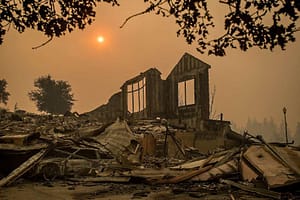We have all witnessed the difficult times our Californians have suffered due to wildfires in Northern California and Anaheim. This year, our firefighters and volunteers had to divide their efforts and supplies to deal with the multiple fires, which caused 42 dead and more than 8,000 strongly affected properties.We have all witnessed the difficult times our Californians have suffered due to wildfires in Northern California and Anaheim. This year, our firefighters and volunteers had to divide their efforts and supplies to deal with the multiple fires, which caused 42 dead and more than 8,000 strongly affected properties.
Hard times are here and only a few will recover soon with the help of adequate home fire insurance coverage. For others, the recovery will be only partial and slow. Many families’ thoughts are: Now what? Do we relocate? Or, do we rebuild? On PBS News Hour, I heard Cat Wise reporting from Santa Rosa and showing the struggles the affected families are living:
- Families just left their homes with few possessions
- Some are moving in with friends or relatives
- Some are taking the few hotels rooms available
- Some others are modifying offices into small apartments
It’s evident that there is a big shortage in housing and that the rental market will be more competitive, with fewer properties available and more homeless people. As the report indicates, these year’s wildfires affected “a wide spectrum of house inventory, from low-income mobile home parks, to middle-class ranches to multimillion-dollar mansions”. On these sad moments, one tries to remember if our fire insurance police have full coverage and contain a clause for temporary housing. We need to learn from the experience of those families affected by the fire today and call our insurance agent to get the responses we need. One thing is clear: The rebuilding process will take, not months, but several years. And this process will be fast or slow, depending on the fire insurance coverage you have, if any.
It’s heard that cities and counties will help to search for options in short-term housing, expediting the rebuilding as much as possible waiving fees for new building permits. However, the rebuild of a property will cost higher than expected due to reasons:
- New properties will be built under the new building codes. These means that our walls, roofs will protect us much better than the original homes built several years ago.
- Right now there is a shortage of materials. Texas, Florida and Puerto Rico already have some big problems rebuilding complete neighborhoods and now California is joining the line.
So what should our home fire insurance need to have to avoid headaches on this situation? I read some articles that may help understand what to do, but it’s better you talk with your insurance agent about the following:
1. Basic Fire Coverage. Typically, a standard homeowner’s policy includes a provision for fire coverage and will pay to repair or replace your home and its contents. The only question regarding this basic coverage is whether the policy pays replacement value for cash value. Replacement value is the amount of money it takes to replace everything was at current market prices. Cash value pays the equivalent of what your property was worth when you first acquired it, minus depreciation.
2. Add to your Basic Fire Coverage the cost of Temporary housing and Clean up after a fire. These are additional coverages to your standard one and you must specifically request before they are added to your policy.
3. Temporary housing can be reimbursed also under Loss of Use coverage or Additional Living Expenses. This coverage should be available if damage covered under your insurance policy has made your home uninhabitable, or if a law enforcement or government agency has ordered your home evacuated due to a covered event. You may even be able to get an advance payment to get you started.
Experts also recommend you have a few documents on hand to speed up the process of securing temporary housing:
- Credit report
- Proof of employment
- Proof of income if you’re self-employed
- Proof of loss of use coverage from your insurer
It is recommendable you save all your receipts, if you go into temporary housing, to get reimbursed by your insurance company. And make sure your insurance company approves any big-ticket expenses beforehand.
In case you don’t have any insurance or temporary housing coverage in your insurance, you may still receive some help from two FEMA programs. These work well once a major disaster is declared:
- Transitional Sheltering Assistance will pay for a hotel room “for a limited period of time”.
- Housing Assistance will provide two months of expedited rental assistance for temporary housing. You will need to register at DisasterAssistance.gov.
Remember it is wise to be careful and protect you and your properties against risk rather than be careless.
Sources:
• California housing shortage adds stress for now-homeless fire victims
https://www.youtube.com/watch?v=GFZc4wCe_wQ
• FAQ: Does My Insurance Cover Temporary Housing during A Fire
http://www.jarvisconstruction.com/news/FAQ-Does-My-Insurance-Cover-Temporary-Housing-During-A-Fire_AE562.html
• How to Get Temporary Housing After a Fire or Other Disaster
https://www.corporatehousing.com/blog/temporary-housing-after-a-fire/
• Does Home Insurance Cover Hotel Stays In The Event Of An Emergency?
https://www.homeinsurance.org/articles/does-home-insurance-cover-hotel-stays-in-the-event-of-an-emergency/
• FEMA Transitional Sheltering Assistance
http://www.femaevachotels.com/
• FEMA Disaster Assistance
https://www.disasterassistance.gov/

